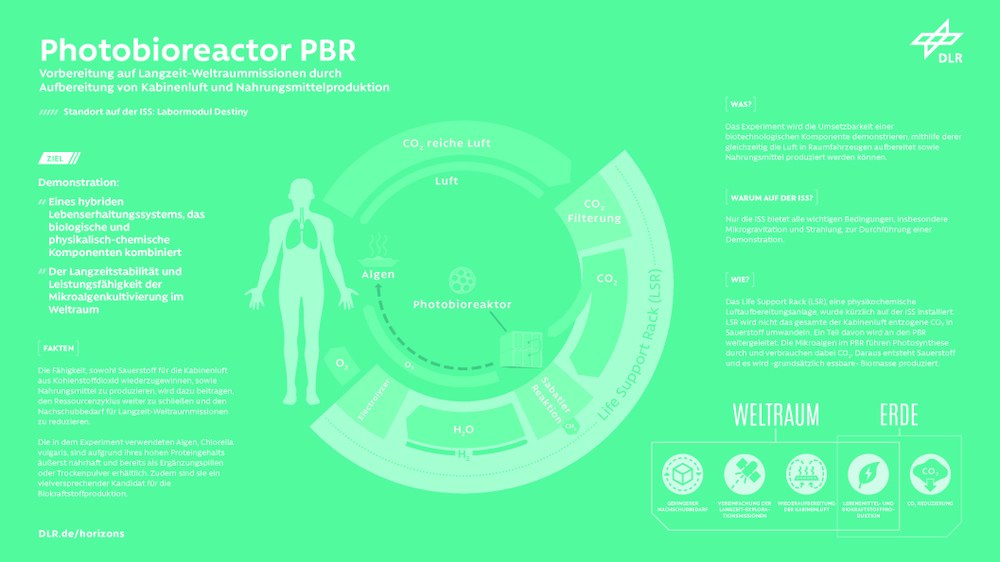Algae on an extraterrestrial mission – giving ISS astronauts air to breathe


- The German-built Photobioreactor experiment is scheduled to fly to the International Space Station on 30 April 2019.
- Inside the technology demonstrator are algae that convert the carbon dioxide exhaled by astronauts into oxygen.
- The photobioreactor will be connected to a physicochemical life support rack, thus demonstrating the functioning of a hybrid life-support system for the first time.
- Focus: spaceflight, long-term missions
Whether it involves an outpost on the Moon or a long flight through space, humans are unable to survive in space without technological systems that provide everything necessary for life. For long-term missions, it is necessary to close the resource cycle to the greatest extent possible in order to survive without relying on deliveries of fresh supplies. The innovative Photobioreactor experiment promises to make a large leap towards a closed cycle. In the experiment, algae convert the carbon dioxide exhaled by astronauts on the ISS into oxygen and edible biomass by means of photosynthesis. The Institute of Space Systems at the University of Stuttgart and the German Aerospace Center (Deutsches Zentrum für Luft- und Raumfahrt; DLR) Space Administration initiated the development of the experiment, while Airbus Defence and Space in Friedrichshafen built the demonstrator. The photobioreactor experiment on the ISS will demonstrate the combination of an innovative biological air-treatment system using algae and a physicochemical system for the first time. This is important for future base stations on the Moon or Mars.
The Photobioreactor experiment is scheduled to lift off for the International Space Station on board a SpaceX Falcon 9 launcher on 4 May 2019. Departure from space launch complex SLC-40 at Cape Canaveral Air Force Station is scheduled for 08:48 CEST (02:48 local time). This will be the 17th regular cargo flight of a Dragon space transporter. The launch was originally scheduled for 16 November last year. The launch scheduled for 1 May was cancelled due to power problems on the ISS. The launch on 3 May could not take place either, due to a malfunction on the SpaceX autonomous spaceport drone ship.
The algae that live inside the Photobioreactor belong to the species Chlorella vulgaris, which is very resilient and has been the subject of extensive research on Earth. The small aquatic organisms in the reactor use the principle of photosynthesis for the production of oxygen, needing only light and some nutrient solution for this purpose. Another strength of the greenish freshwater algae is that it is a suitable form use as food. The further processing of the emerging biomass is not examined in the current experiment, but it would be possible in principle. Less food would then have to be carried or subsequently delivered on space missions, further increasing the closed nature and sustainability of the system. About 30 percent of an astronaut’s food could be replaced by algae biomass, due to its high protein content.
“With the first demonstration of the hybrid approach, we are right at the forefront when it comes to the future of life-support systems. Of course, the use of these systems is interesting primarily for planetary base stations or for very long missions. But these technologies will not be available when needed if the foundations are not laid today,” says Oliver Angerer, team leader for Exploration and project leader for the Photobioreactor experiment at the DLR Space Administration.
Photobioreactor forms a hybrid system with the physicochemical air reprocessing plant
The Photobioreactor is expected to help produce breathable air on the International Space Station for six months. It will be supported by the Advanced Closed-Loop System (ACLS) in this process. This physicochemical air recycling plant, which was built by Airbus in Friedrichshafen, has been on the ISS since September 2018. It was transported there by a Japanese HTV space freighter and installed in the US Destiny laboratory.
Airbus built the air recycling plant – which is about two metres tall and one metre wide – as a technology demonstrator. Nonetheless, it remains part of the ISS life-support system for the time being and generates oxygen for the astronauts. The ACLS uses part of the carbon dioxide from the cabin air in order to extract methane and water from it. The water, which is formed in this Sabatier process, is then fed back into the electrolysis process to produce oxygen. This increases the efficiency of the overall system and minimises the need for water supplies delivered from Earth.
However, the ACLS cannot use all of the carbon dioxide from the breathing air to produce water. The algae in the Photobioreactor process some of the remaining carbon dioxide to generate oxygen, thus complementing the output of the ACLS. In this way, a hybrid system – called PBR@ACLS – emerges from the interaction of this biological system with the physicochemically-based ACLS.
As a result, the functioning of a hybrid life-support system will be demonstrated for the first time under real space conditions.
The Photobioreactor's contribution to oxygen production is nowhere near enough to cover the daily needs of a person, so the scientists are currently aiming to demonstrate the functioning of such a hybrid system. In the future, reactors could be much larger and constructed in such a way that they are, for example, part of the inner walls in a space habitat, such as on the Moon or on Mars.
However, hybrid systems – such as the PBR@ACLS photobioreactor – not only help to make long-term space missions a reality. They can also increase sustainability on Earth by saving and recovering resources. The space industry can learn from our ecosystem in this regard. Conversely, the system is another example of how developments in the space sector deliver technologies to help maintain humanity’s habitat on Earth. Possible uses include air treatment in sealed environments and the reduction of carbon dioxide.

